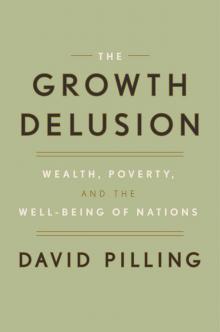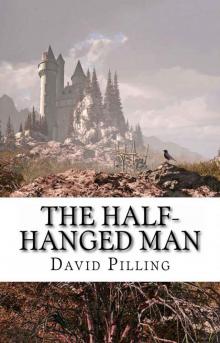- Home
- David Pilling
The Growth Delusion Page 14
The Growth Delusion Read online
Page 14
“We shouldn’t worship GDP and we shouldn’t abandon GDP,” he said on another occasion. “Our aim is to have a GDP that consumes fewer natural resources, is less harmful to the environment and has a low social management cost. We want rational, genuine GDP.”10
Niu is an idealist. He is after something that no economist—perhaps no social scientist—has yet discovered: how to quantify what he calls a green mentality. His ultimate goal, he says, one that sounds naively out of sync with a frenetically modernizing China, is to discover “the green in people’s hearts.” Only then, he says, “when people get wiser can GDP be green.”
* * *
—
In March 2013 residents of Shanghai awoke to find the carcasses of thousands of pigs floating down a suburban river. A few years before, as China prepared to host the summer Olympics of 2008, mysterious algae began to spread—like the protagonist of some horror movie—off the coast, threatening the sailing events in the port city of Qingdao. By the time the authorities began to bring it under control, the algae had spread several hundred miles along the eastern seaboard. State media played it down, quoting scientists saying the outbreak was a natural phenomenon. Chinese environmentalists begged to differ, blaming the visitation on industrial pollutants and fish farming. “The natural ecosystem of the ocean has been destroyed, which is why strange events such as this can happen,” said Wen Bo, coordinator of Save China’s Seas Network.11
Two-fifths of China’s river water is undrinkable and one-sixth is so polluted it is unfit for any use. The baiji, or Goddess of the Yangtze, one of only four types of exclusively freshwater dolphins, has been driven to extinction, ending its 20 million years on earth. Though air pollution has grabbed most of the headlines, soil erosion is just as catastrophic.12 Soil accounts for just a few inches—or at best a few feet—of the earth’s surface. Once eroded by overcultivation, blown away or washed into the rivers and oceans, it is replaced only over geological time. According to one estimate, soil is eroding in China thirty to forty times faster than it can be replaced naturally. China is also scattered with “cancer villages” such as Xinglong in Yunnan province, where a local chemical plant has dumped thousands of tons of waste chromium—a known carcinogen—into the nearby hills and river.
To be fair—something that people writing about the negative impacts of economic expansion not always are—China’s growth brings many benefits too. Air pollution may cause as many as 1.2 million premature deaths a year, but it is equally true that China’s remarkable economic progress has contributed to a leap in life expectancy, which has more than doubled from thirty-five in 1949 to seventy-five today. That outpaces gains in most other countries and reflects a dramatic rise in the standard of living of most people, bringing better food, better hospitals, and better housing.
Whether or not China’s growth threatens the planet—as well as its own sustainability—is a matter of conjecture. Ever since Thomas Malthus, a cleric and scholar who wrote his famous An Essay on the Principle of Population in 1798, people have been predicting that the earth is reaching its natural limits. Malthus thought that population growth would always outpace improvements in agricultural production, ensuring that living standards would stall and eventually catastrophe would strike. Malthus has been much pilloried. Like a stock market analyst forever predicting a crash, his ghost has had to watch on as the world has forged ahead into bull market territory.13 Certainly, there have been famines, war and pestilence, but the human population has grown exponentially and despite all the poverty that still remains, has grown immeasurably richer.
One of the patterns of industrial growth has been that, in the early stages of development, countries pollute. Then, as they grow richer and more technologically advanced, they clean up. Take London, which as late as 1952 had “pea souper” pollution days. So foul was the air on some occasions that the greyhound races at White City were abandoned because the dogs could not see the mechanical hare they were meant to be chasing.
London in 1952 sounds like Beijing in 2015. Yet some think China’s industrialization may be the final straw for the planet. That is because of China’s scale. Other countries, as they have grown richer, have managed to push polluting industries to other, poorer countries, like a game of pass the parcel. Much of the pollution that goes to make American and European goods has simply been outsourced to China. The question is, when China finally gets rich enough, will it be able to pass the parcel to someone else, say Africa? Or is the collective parcel of global production now simply too large to be palmed off? As it closes the wealth gap on America, might China’s emission of CO2 alone lead to an unsustainable rise in temperatures, triggering catastrophic changes in global weather patterns? If China is unable to repeat the trick that other nations managed as they climbed up the industrial ladder, Malthus might just have been a couple of hundred years early in his prediction.
Of course China may be able to clean up by applying technology, shifting from manufacturing to services, and gradually repairing some of the damage already done. But to do so it will first have to recognize the problem. In some ways that is already happening. In 2015 Chai Jing, a former journalist for state broadcaster China Central Television, uploaded to the Internet a documentary she had made and financed herself. It was called Under the Dome and it dealt with the environmental catastrophe in the coal-mining province of Shanxi. In the film’s most poignant moment Chai asks a six-year-old girl if she has ever seen the stars. She has not.
The reaction to the film was nothing short of breathtaking (excuse the pun). It was downloaded more than 150 million times even though it was quickly removed by China’s censors. Nevertheless, the environment minister at the time praised the film, comparing it favorably with Silent Spring, a 1962 book by Rachel Carson that attacked the chemical industry and is credited with sparking the modern environmental movement. Even before the film came out, in 2014, Li Keqiang, the Chinese premier, had declared a “war on pollution,” and called smog “nature’s red-light warning against the model of inefficient and blind development.”
We should be cautious of the rhetoric of China’s leaders. But we also need to acknowledge that much has changed. As one report argues, Beijing “has become a green energy juggernaut after designating renewables as a strategic industry. China has more than a third of the world’s wind power capacity; a quarter of its solar power; six of the top ten solar-panel makers; four of the top ten wind-turbine makers and more battery-only electric car sales last year than the rest of the world combined.”14
Beijing’s switch to renewable energy—including nuclear—is hampered by the fact that the country still has a lot of catching up to do if it wants to match Western standards of living. That will mean years of fast growth, even though Beijing’s leaders have been gradually lowering expectations about what is possible, from the double digits of just a few years ago to below 7 percent. And although the share of non-fossil fuel energy is increasing, absolute levels of dirty energy are continuing to grow. In 2016 a Chinese official said coal power generation could increase by one-fifth over the following five years alone.15
Some of the improvements China is making, including in the quality of air, involve a domestic pass-the-parcel. In the first three months of 2016 Beijing’s average concentration of PM2.5 (fine particulate matter) was down 28 percent, year on year, reflecting the results of a concerted crackdown. Shanghai’s air was 12 percent better, according to data collected by Greenpeace. But while coal-fired plants were being closed in northern Hebei province, a neighbor of Beijing, they were being built in central and western provinces, where regulations are laxer. Of the cities surveyed there, ninety-one reported an increase in air pollution.16
Still, a study in 2016 conducted by the London School of Economics found that Chinese carbon emissions would peak in 2025, and might even have already done so. It maintained that projections were too bleak because China’s economy was already shifting
from heavy industry to less carbon-intensive technology and services. Xie Zhenhua, China’s top climate negotiator, said his country’s CO2 emissions had not peaked and were still climbing because of the construction and vehicle ownership that came with urbanization. But, he said, they might stabilize soon because of China’s policy shift. “In reality, our CO2 emissions are still increasing, but the efforts we are making are very big.”17
Things were beginning to change politically as well. Niu’s green GDP was beginning to catch on. In 2015 China’s environment ministry again floated the idea that the performance of provincial officials should be judged partly by progress on improving the environment. In 2014 more than seventy smaller cities and counties jettisoned GDP as a performance metric for government officials, prioritizing environmental protection and poverty reduction instead. That summer President Xi had told party officials, “We need to look at obvious achievements as well as hidden achievements. We can no longer simply use GDP growth rates to decide who the [party] heroes are.”18
Internationally too, Beijing had gone from laggard to putative world leader. Even as Donald Trump was pulling America out of the Paris Climate Agreement, Beijing agreed with the European Union to accelerate what was called a historic shift away from fossil fuels. Wang Hui at the University of International Relations in Beijing said Washington’s withdrawal had given China the opportunity to lead. “Trump is a businessman who emphasizes America’s own interests rather than common interests. China and Europe must now step up and assume our international responsibilities together.”19
As green technology advances, the arguments about a trade-off between growth and pollution may prove a red herring. Some of that apparent trade-off is simply because we are not measuring things correctly. Are the parts of “growth” that make people’s life miserable and kill them off prematurely really worthy of the name? Admiration for Li Dakang, the go-for-growth local official in In the Name of the People, suggests not all Chinese people see it that way. Perhaps if you are escaping from poverty, you want growth in whatever form and at whatever cost. But even Li might agree that it would be better to have the data so one could judge more precisely what the trade-offs are.
As Jonathan Watts, a reporter and keen observer of China’s environment, was leaving China in 2012, he gave a memorable speech. In it he said that Beijing had made almost no political reforms during his nine years in the country but had achieved vast leaps in terms of environmental reform. He listed anti-desertification campaigns, tree planting, an environmental transparency law, adoption of carbon targets, eco-services compensation, eco accounting, caps on water use, lower economic growth targets, the Twelfth Five-Year Plan, debate and increased monitoring of PM2.5, and investments in renewables and clean tech.
Of course that didn’t mean China was any cleaner. During the same nine years the size of China’s economy had quadrupled, there were five times as many cars on the roads, and carbon emissions had doubled and surpassed those of the US. The country now accounted for almost half the coal burned on the planet. China, said Watts, was both a “black superpower” and a “green superpower.” It could kill the world, but it could also save it.
10
WEALTH
Imagine for a moment two people, Bill and Ben. Bill is a banker and earns $200,000 a year at Goldman Sachs. OK, he’s miserably paid by banking standards, but bear with me. Ben is a gardener and earns $20,000 pruning roses and trimming hedges. Who is better off? If you measure the income each receives, then Bill is clearly richer, in fact precisely ten times richer. This measurement is the equivalent of GDP; it tells you about the “flow” of income each receives in a particular year. But, just like GDP, these numbers don’t reveal much about the true wealth of Bill and Ben.
To discover more, you’d need to know about their stock of assets. Did I forget to mention that Ben the gardener recently inherited a huge country estate in Long Island worth $100 million? In truth, he works in his own vast garden as a bit of a hobby on Tuesday afternoons and pays himself a token wage. But he plans to sell off the estate next year, move into somewhere more modest in Manhattan, and live off the interest from investing the $95 million or so he’ll have left over.
Poor Bill, meanwhile, is up to his neck in debt. He has to fork out half his salary each month on his mortgage, which has another ten years to run. He has car payments on his (scratched-up) Porsche and a troubling bank overdraft that he’s acquired to maintain his highfalutin lifestyle. Unfortunately, he’s also pushing fifty (Ben is nineteen by the way) and the bank is going to have to let him go.
Now who looks better off, Bill or Ben?
Our standard growth measurement tells us everything about income and nothing about wealth. This is one of its fundamental shortcomings. That goes for nations as well as individuals. Growth numbers for Saudi Arabia are virtually meaningless. Why? Because they are predicated on flows of oil, which will one day run out. At that point, unless Saudi Arabia has discovered another method of producing today’s level of income, its economy will shrivel.1 Saudi Arabia would then become the Bill-the-banker of nations.
Measuring wealth—the stock of assets—is indispensable if we are to get a true picture of the world. And yet, when it comes to national accounts, we have limited tools at our disposal. National accounts contain huge amounts of information, but these are rarely brought to light by growth-obsessed policymakers who home in on only one of the numbers—GDP—at their disposal.
That is extraordinary if you stop to think about it. When investors are sizing up a company, they look not only at its profits and losses, but also at its balance sheet. The profit and loss account, sometimes known as the income statement, shows the flow of revenues and expenditure over a set period. Broadly speaking, if revenues exceed expenditure, the company is in profit. If not, it is in loss. The balance sheet is different. Rather than measuring the flow of incomings and outgoings, it takes a snapshot. It lists assets, liabilities, and shareholder equity. It shows what the company owns and what it owes. In the process it reveals what a company is actually “worth” rather than merely showing the profits it is able to generate this year—but not necessarily in the years ahead.2
Politicians and policymakers rely on only a threadbare set of accounts by comparison. We call it GDP. It is the equivalent of an income statement. Beyond a few experimental satellite accounts, there has been no systematic attempt to measure a nation’s stock of assets, or what we might call its wealth.3 “There’s been no innovation in national accounts. It’s totally stuck,” says Umair Haque, a leather-jacket-wearing economist. He regards this as a shocking failure. It is urgent, he argues, for the so-called great economic minds, including those at multilateral bodies like the IMF and World Bank, to come up with wealth measures to match all the countless revisions and updates that have gone into perfecting measurements of growth. “Why isn’t there innovation in national accounts that lets us have a more accurate picture of the economy? Without a measure of national wealth we have no idea,” he fumes (literally), cigarette in one hand and espresso in the other. “Without a picture of the stocks, we can’t say with any accuracy how wealthy we really are.”
* * *
—
Partha Dasgupta is the Frank Ramsey professor emeritus at Cambridge University and a pioneer of environmental economics. He has spent much of his career looking at how we might think differently about our economies. I went to Cambridge to talk to him. He met me outside the imposing Great Gate of St. John’s College, dressed in a suit jacket, trousers, and white trainers. For a man of seventy-four, he looked trim and agile. He walked me to his book-lined study near the River Cam, where he offered me sherry, a throwback to a more genteel age. I readily accepted. It was, after all, already 11 a.m.
Like many people who have made their home in a new country—Dasgupta was born in what is now Bangladesh but came to England in the early 1960s to do a PhD in economics at Trinity College, Cam
bridge—he is more English than the English. He has a gentle, refined way about him. Dasgupta is not so much a critic of growth as convinced that it is measuring the wrong thing. Whatever unit we are studying—households, nations, or the planet as a whole—we ought to be interested not in income but in wealth, he argues. By wealth he means “the social worth of an economy’s stock of capital assets, comprising manufactured capital (roads, ports, machinery, and so on), human capital (population size and composition, education, health), knowledge (the arts, humanities, and sciences), and natural capital (ecosystems, sources of water, the atmosphere, land, sub-soil resources).”4
That seems like a tall order. How on earth, for example, could we put a numerical value on knowledge or culture? Dasgupta is not oblivious to the conceptual difficulties, but he has two responses. One is that since the 1940s humans have invested huge intellectual capital and tens of billions of dollars in creating, revising, and refining growth measurements. In comparison, the effort to produce a balance-sheet version of national accounts has been minuscule. “Never mind how difficult it is to estimate. The fact that it’s very difficult to estimate is not an argument for running away from it,” he says firmly. “Because GDP is also very difficult to estimate.”
Second, he says, the best intellectual approach to any problem is to push a hypothesis to its limit and then retreat if things turn out to be too hard. Conceptually, we ought to have a balance sheet of our national economies, a snapshot of what we own and what we owe. So we should not shrink from the task; instead we should put our collective brains into creating one.

 The Growth Delusion
The Growth Delusion The Hooded Men
The Hooded Men Longsword
Longsword Medraut
Medraut Hardway
Hardway Holy Warrior
Holy Warrior Caesar's Sword: The Complete Campaigns
Caesar's Sword: The Complete Campaigns The Wolf Cub
The Wolf Cub Reiver
Reiver The Heretic
The Heretic Siege of Rome
Siege of Rome Loyalty
Loyalty The Path of Sorrow
The Path of Sorrow Caesar's Sword (I): The Red Death
Caesar's Sword (I): The Red Death Flame of the West
Flame of the West The Best Weapon
The Best Weapon Sacrifice
Sacrifice The Half-Hanged Man
The Half-Hanged Man